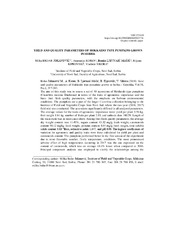Приказ основних података о документу
Yield and quality parameters of hokkaido type pumpkins grown in Serbia
| dc.creator | Brdar-Jokanović, Milka | |
| dc.creator | Koren, Anamarija | |
| dc.creator | Ljevnaić-Mašić, Branka | |
| dc.creator | Kiprovski, Biljana | |
| dc.creator | Sikora, Vladimir | |
| dc.date.accessioned | 2021-04-26T19:44:08Z | |
| dc.date.available | 2021-04-26T19:44:08Z | |
| dc.date.issued | 2019 | |
| dc.identifier.issn | 0534-0012 | |
| dc.identifier.uri | http://fiver.ifvcns.rs/handle/123456789/1857 | |
| dc.description.abstract | The aim of this study was to assess a set of 40 accessions of Hokkaido type pumpkins (Cucurbita maxima Duchesne) in terms of the traits of agronomic importance and the basic fruit flesh quality parameters, with the emphasis on Serbian environmental conditions. The pumpkins are a part of the larger Cucurbita collection belonging to the Institute of Field and Vegetable Crops from Novi Sad, where the two-year (2016, 2017) field trial was conducted. The accessions significantly differed in all analyzed parameters. The average values for the traits of agronomic importance were: yield per plant 3.56 kg, fruit weight 1.84 kg, number of fruits per plant 2.03, and anthesis date 180.29. Length of the main stem was in most cases short. Among fruit flesh quality parameters; the average dry weight content was 11.49%, sugars content 43.32 mg/g fresh weight, carotenoids content 50.12 mg/kg fresh weight, proteins content 4.04 mg/g fresh weight, total soluble solids content 8.63 degrees Brix, refractive index 1.347, and pH 6.98. The highest coefficients of variation for agronomic and quality traits were those calculated for yield per plant and carotenoids content. The pumpkins performed better in the first season of the experiment due to more favorable weather, firstly temperature, conditions. The most pronounced adverse effect of high temperatures occurring in 2017 was the one expressed on the content of carotenoids, which was on average 48.4% lower when compared to 2016. Principal component analysis was employed to clarify the relationships among the investigated parameters, and to distinguish those with the most important contribution to the pumpkin variability. The analysis revealed strong correlations among yield per plant, fruit weight and length of the main stem. Carotenoids content and pH also correlated to yield, while the other quality parameters correlated to each other. Defining both first and second principal components, yield per plant and fruit weight were the parameters with the highest contribution to the variability among the assessed pumpkins Concerning quality parameters, fruit flesh dry weight contributed the most to the variability. Therefore, the strategy for breeding Hokkaido type pumpkins adapted to Serbian environmental conditions should be based on combining irrespectively selected high-yield and high-quality accessions. | en |
| dc.publisher | Društvo genetičara Srbije, Beograd | |
| dc.relation | info:eu-repo/grantAgreement/MESTD/Technological Development (TD or TR)/31059/RS// | |
| dc.relation | info:eu-repo/grantAgreement/MESTD/Technological Development (TD or TR)/31005/RS// | |
| dc.rights | openAccess | |
| dc.rights.uri | https://creativecommons.org/licenses/by-nc-nd/4.0/ | |
| dc.source | Genetika-Belgrade | |
| dc.subject | Cucurbita maxima | en |
| dc.subject | Hokkaido pumpkin | en |
| dc.subject | PCA | en |
| dc.subject | quality parameters | en |
| dc.subject | yield | en |
| dc.title | Yield and quality parameters of hokkaido type pumpkins grown in Serbia | en |
| dc.type | article | |
| dc.rights.license | BY-NC-ND | |
| dc.citation.epage | 387 | |
| dc.citation.issue | 2 | |
| dc.citation.other | 51(2): 377-387 | |
| dc.citation.rank | M23 | |
| dc.citation.spage | 377 | |
| dc.citation.volume | 51 | |
| dc.identifier.doi | 10.2298/GENSR1902377B | |
| dc.identifier.fulltext | http://fiver.ifvcns.rs/bitstream/id/780/1854.pdf | |
| dc.identifier.scopus | 2-s2.0-85071124767 | |
| dc.identifier.wos | 000484834400004 | |
| dc.type.version | publishedVersion |


